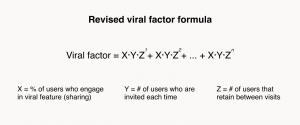This article is a visual summary of the essay Why the best way to drive viral growth to increase retention and engagement by Andrew Chen.
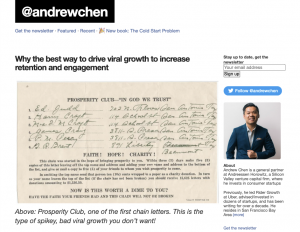
📈 An intro to viral growth
When it comes to brands, there are two marketing approaches to virality:
1. Conventional approach—invite friends ASAP
This is thinking of ways to force users to invite friends as soon as they sign up and implementing tricks like inviting all contacts at once.
An example would be the invites to Facebook games we all used to get:

2. Alternative approach—retention fuels virality
If a user retains well every day for a month, you have 30 opportunities to prompt them to invite a friend. You have more than 30 shots/month to create virality.
That is because a sticky product has time to prompt users to invite throughout their journey. However, a product with “one-and-done” retention needs aggressive marketing even before the onboarding is complete.
In the long term, retention is what creates sustainable viral growth.
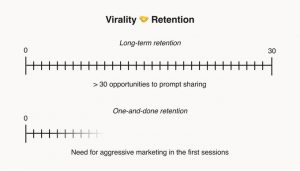
But what is viral growth in the first place?
It is not funny viral videos or spontaneous social sharing of a brand’s YouTube ad.
It is network-driven viral growth that sustains in the long term.

Some examples of products with network-driven viral growth are:
Slack—invite colleagues to chat.
Dropbox—native folder sharing.
PayPal—badges and P2P payments.
Instagram—Invite and connect with Facebook friends.
The growth strategies of these unicorns have something in common.
The Product/Network Duo.
- The product has features to attract people to the network.
- The network brings more value to the product.
It is a recursive growth loop where the two forces complete each other.

You can’t build a Facebook-sized user base with traditional marketing.
Tactics that need billions in CAC don’t work at that scale.
Viral growth is the only option because the customer acquisition cost is zero.
But where do you start?
🤔 Ask the following:
“How does your product grow itself, based on its network of users to attracting their friends/colleagues?”
Once you have that, use referral software to make virality more effective over time and achieve a competitive advantage.
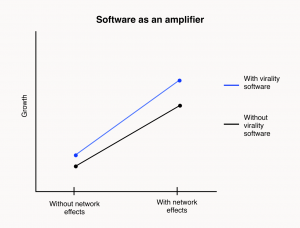
So to answer the original question, “What is viral growth?” :
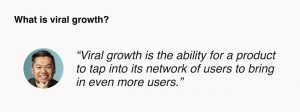
➗ The math of viral growth
The viral factor is the measurement/key result of viral growth—it’s the single metric of how well the existing audience invites the next batch of members.
If you have 1000 members and they invite 500 friends, you get a virality factor of:
500/1000 = 0.5

A userbase’s growth rate can be expressed as a function of the viral factor. A viral factor of 0.5 = 1/(1-v0.5) = 2x growth rate. Aka, if you start with 1000 members, you’ll reach 2000. A 0.1 difference in your viral factor affects the growth rate tremendously.
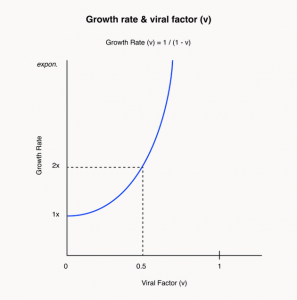
Like all things in business, “What gets measured gets done.” So, If you have a measurement of virality, you can work to maximize it, and it will work for you.
Sometimes, a project may get a viral factor of > 1.0. In other words, 1000 users invite 1100, the new 1100 will invite 1210, etc.
A viral factor of > 1.0 means exponential growth. But should this be the goal?

The viral factor can mislead to optimization for the wrong goal—that is how the first social networks (2005-2010) and Facebook games operated and collapsed.
They followed a naive version of the viral factor, where:
X = % of users who invite friends
Y = # of friends they invite
X*Y = viral factor
The only goal was to increase Y and X.
That motivated those companies to:
- Get people to invite as many friends as possible.
- Use techniques like inviting a whole friend list to maximize invites per user.
- Prompt people to invite friends early on sign up before the natural drop-off.
Such schemes have network effects but only grow in the short term.
They are about getting users quickly and not retaining them. They are driven by novelty and require a constant inflow of new people (a.k.a pyramid schemes).
But where did these spam strategies start? (it was not the lame Facebook games)
🤬 The predecessor to spammy viral invites.
The first instance of highly viral (but ineffective) mechanics came around the 1800s in the form of Chain letters.

This scheme grew using viral mechanics which are techniques that grow quickly and collapse after reaching many participants. They value short-term user growth more than retention.
Here, people sent $0.10 to other club members, and once receiving the letter, they added themselves to the list and forwarded it to friends.
The promise was that everyone will get money from others’ donations to the club. Ideally, everyone would get $32,182 (2022 dollars) from donations.
The Prosperity Club mail chain grew to more than 100,000 people within months.
It flooded the US Postal Office, which later banned this kind of scam letters.
Unfortunately, chain letters like this take advantage of people’s despair.
They capitalized on people’s hope after the Great Depression—not cool.
“Faith! Hope! Charity!”
Chain letters have network effects, the value increases as more people join the “club”, but, they are all about getting participants quickly, not retaining them.
They require a constant inflow of new people, or they collapse. Aka. a pyramid scheme.
Pyramid schemes fail because the math behind them is broken.
They can exist as long as there are people to join.
Even if everybody invites their friends, they eventually run out of humans to invite.

💡The new viral growth approach and its principles
Facebook, Slack, and Dropbox established the new approach to viral growth that helped them sustainably scale over many years.
However, despite their scale and growth rates, they were the most nonchalant about viral growth, not spammy invites, and barely any paid advertising.
Their viral hooks felt as natural as sharing a folder.
They succeeded by focusing on retention, and it changed their math entirely.
We can derive 4 principles from such immense and sustainable viral growth:
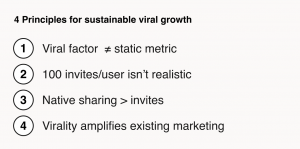
1. Viral factor ≠ static metric.
People share over time, not only when they join.
100 users invite 10 friends the first week, then 5, then 7 later, and so on.
The more sessions you have with a user (retention)— the more you build up the viral factor over time.
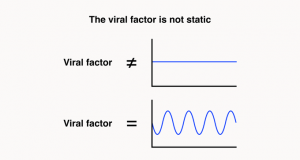
2. Asking people to invite 100 contacts is not realistic.
Scam scores will punish you for mass-inviting all your contacts and your domain might even get flagged.
To grow, one should have users invite small batches of other users in natural use cases over time.
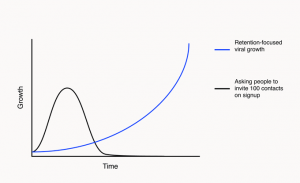
3. Sharing > invites.
- Dropbox had a folder-sharing mechanism before their referral program.
- Instagram pioneered cross-platform promotion with the ability to share on Facebook.
Then, if you embed a native sharing mechanism in your product, referral marketing programs will multiply your growth by rewarding your most loyal customers.
4. Virality amplifies other channels rather than being a core driver.
While >1.0 viral factors aren’t realistic, a 0.5 changes everything.
Thus, you should use virality to amplify other marketing activities that bring traffic like SEO, content, PR and more.
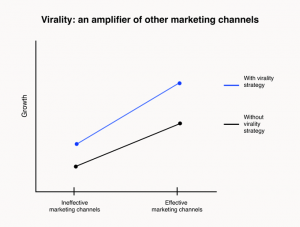
🤌 Conclusion
To sum up, your growth strategy should prioritize retention over aggressive promotions. Companies can only do that by creating a good product that becomes a habit to use.
Then, to grow virally, you should embed native sharing functionalities that add value to the user if they bring their friends on board (product/network duo).
If those principles are in place, successful marketers should implement a referral marketing program to top it off and measurably amplify their viral growth.
The revised (more realistic) model of viral growth.
X and Y tend to be small—few users invite few users.
But if your Z (retention) is strong, the viral factor will sum up to something great.
